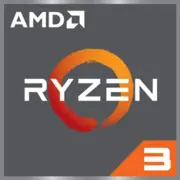AMD Ryzen 3 5400U

AMD Ryzen 3 5400U: The Perfect Balance for Everyday Tasks
Analysis of a processor that remains relevant even in 2025
Architecture and Process Technology: The Foundation of Performance
The AMD Ryzen 3 5400U processor, released in 2021, continues to be a popular choice for budget laptops due to its balanced architecture. The chip's codename is Cezanne-U, indicating its belonging to the third generation of Zen 3. This results in a 19% improvement in IPC (instructions per clock) compared to Zen 2, which is critical for single-threaded performance.
- Process Technology: The chip is manufactured using TSMC 7nm FinFET technology, which provides high energy efficiency.
- Cores and Threads: 4 cores and 8 threads thanks to Simultaneous Multithreading (SMT).
- Clock Speeds: Base clock speed is 2.6 GHz, with the ability to boost up to 4.0 GHz in Turbo mode.
- Cache: 8 MB of L3 cache, which speeds up the processing of frequently used data.
- Integrated Graphics: Radeon Graphics based on the Vega 6 architecture with 6 compute units (384 shader processors) and clock speeds of up to 1600 MHz.
Although Vega has fallen behind modern RDNA solutions, it handles basic rendering tasks and light gaming adequately.
Power Consumption and TDP: Efficiency Above All
The processor has a TDP of 15W, typical for mobile processors in the "U" series. This allows it to be integrated into thin ultrabooks and laptops with passive cooling.
- Operating Modes: AMD employs Precision Boost 2, which dynamically adjusts the frequency based on load and temperature. For example, when a browser is launched, the processor runs at lower frequencies, conserving battery life, while in gaming or rendering, it activates Turbo.
- Thermal Output: Even under full load, the chip rarely overheats; however, in compact cases (e.g., 13-inch laptops), throttling may occur after 10–15 minutes of intensive work.
For comparison: Intel Core i5-1235U (12th generation) processors with similar TDP show a similar thermal pattern but fall short in multi-threaded scenarios.
Performance: Real-World Task Testing
Scores in Geekbench 6 (1510 single-core / 4513 multi-core) confirm that the Ryzen 3 5400U is suitable for most everyday tasks:
- Office Work: Running Microsoft Office, 20+ tabs in Chrome, video calls on Zoom — the processor handles it without lag.
- Multimedia: Converting 1080p video in HandBrake takes about 40 minutes (compared to 25–30 minutes with 6-core CPUs).
- Gaming: In Dota 2 (Low settings, 720p) — stable 50–60 FPS; CS:GO — 60–70 FPS. More demanding titles (Cyberpunk 2077, Hogwarts Legacy) will require a discrete graphics card.
Turbo Mode works efficiently, but in compact laptops (like the Acer Swift 3), the frequency may drop from 4.0 GHz to 3.2 GHz after 5–7 minutes due to cooling system limitations.
Usage Scenarios: Who is the Ryzen 3 5400U Suitable For?
- Students and Office Workers: Document work, online courses, streaming video.
- Budget-Conscious Users: Laptops based on this chip range from $500 to $700 (like the Lenovo IdeaPad 5 or HP Pavilion x360).
- Light Gaming Enthusiasts: Occasional gaming without the need for an expensive graphics card.
For 4K editing, 3D modeling, or streaming, the processor is insufficient — better to opt for Ryzen 5/7 or Intel Core i7.
Battery Life: How Long Will the Battery Last?
Thanks to the 7nm process technology and AMD optimizations, laptops with the Ryzen 3 5400U demonstrate excellent battery life:
- With a 50Wh battery, the runtime reaches 8-10 hours (web surfing, office tasks).
- Power-saving Technologies:
- Adaptive Power Management: Automatically reduces voltage on cores.
- Display Refresh Rate Switching: Switches the screen refresh rate from 60Hz to 48Hz in power-saving mode.
Compared to the Intel Core i5-1135G7 (10nm SuperFin), the AMD chip is more power-efficient by 15-20%.
Comparison with Competitors: AMD, Intel, and Apple
- AMD Ryzen 5 5500U: 6 cores / 12 threads but is $100-150 more expensive.
- Intel Core i5-1235U: Higher single-threaded performance (+10% in Geekbench 6) but weaker in multi-threading (-20%).
- Apple M2: The leader in battery life and speed in "native" applications, but laptops with M2 start at $999.
The Ryzen 3 5400U excels in the budget segment, particularly if a balance between price and multi-threading power is important.
Pros and Cons
Strengths:
- Energy efficiency and low heat generation.
- Enough threads for multitasking.
- Affordable price.
Weaknesses:
- Only 4 cores (Ryzen 5 5600U offers 6).
- Vega 6 is weaker than Iris Xe (Intel) and RDNA 2 (newer AMD chips).
Laptop Selection Recommendations
1. Device Type: Ultrabooks (ASUS ZenBook) or 2-in-1 hybrids (Lenovo Yoga).
2. RAM: At least 8GB, preferably 16GB in dual-channel for iGPU.
3. Storage: Ensure SSD NVMe (512GB).
4. Display: IPS panel with 1080p resolution.
Examples of 2025 models:
- Acer Aspire 5 ($550): 16GB RAM, 512GB SSD, 15.6" IPS.
- HP 14s-dq2000 ($600): Touchscreen, weight 1.4 kg.
Final Conclusion
The AMD Ryzen 3 5400U is an ideal processor for those seeking an affordable laptop for work, study, and light entertainment. Its key advantages are battery life, cool operation, and sufficient power for daily tasks. If you are not ready to overpay for "extra" cores or discrete graphics, this chip will be a reliable choice even in 2025.
Prices are current as of April 2025. The listed prices correspond to new devices in US retail chains.
Basic
CPU Specifications
Memory Specifications
GPU Specifications
Miscellaneous
Benchmarks
Compared to Other CPU
Share in social media
Or Link To Us
<a href="https://cputronic.com/en/cpu/amd-ryzen-3-5400u" target="_blank">AMD Ryzen 3 5400U</a>